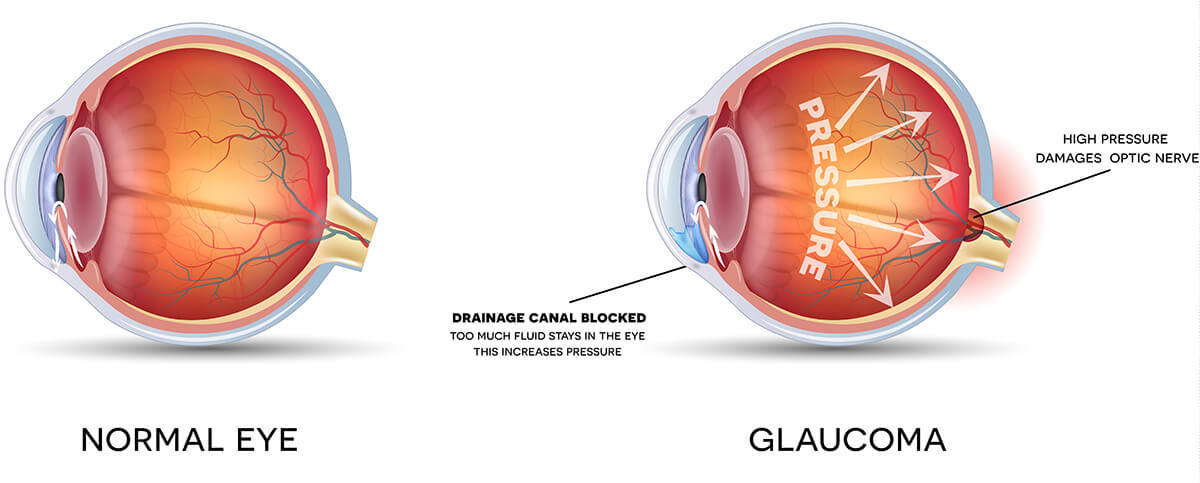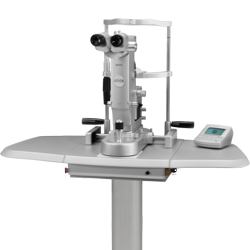Glaucoma Treatments
Glaucoma refers to a group of eye conditions that lead to damage of the optic nerve and can result in blindness. These conditions are classified into different types. The most common kind of glaucoma is known as open-angle glaucoma. Other types include closed-angle glaucoma and normal-tension Glaucoma. Glaucoma occurs when aqueous humor, a fluid produced in the eye, is not drained as it should. This leads to increased pressure inside the eye.
Glaucoma is not curable. There are treatments that can stop the progression of the disease or slow it down. If left untreated, glaucoma will lead to total vision loss.

What Are My Treatment Options For Glaucoma?
There are various treatments used for the different types of glaucoma.
The common treatment methods used are:
- Eye Drops
- Selective Laser Trabeculoplasty (SLT)
- The iStent Procedure
These treatments may be used solely or in conjunction with each other. They all aim to decrease the pressure in the internal regions of the eye. This helps stop further damage to the optic nerve. The optic nerve is important because it transmits visual information to the brain.
Eye Drops for Glaucoma Treatment
Eye drops to treat glaucoma work by decreasing the production of aqueous humor. They also help the eye drain fluid out of the eye better. In this way, the pressure inside the eye is lowered.
This treatment is usually the primary method of treating glaucoma after diagnosis.
What Kinds of Eye Drops Treat Glaucoma?
The kinds of eye drops used for treating glaucoma vary.
The most common kinds of eye drops used are:
Alpha Agonists: These include drugs such as brimonidine, apraclonidine, and dipivefrin. These drugs help manage intraocular pressure by reducing the secretion of the aqueous humor.
Prostaglandins: Prostaglandins improve the drainage of fluids from the eye by relaxing interior muscles. Better outflow results in reduced eye pressure. These eye drops are only administered once daily.
Beta-Blockers: Beta-blockers are usually used together with prostaglandins. They work by decreasing the production of intraocular fluid in the eye.
Parasympathomimetics: In closed-angle glaucoma, they improve the outflow pace of fluid from inside the eye. This lowers intraocular pressure.
Carbonic Anhydrase Inhibitors (CAIs): CAIs reduce the rate at which intraocular eye fluid is secreted. They are often administered alongside other types of eye drops.
These eye drops are distinguished by the active chemical ingredient found in them. At times, a patient may have more than one type of eye drop prescribed. This helps to meet the targeted IOP or Intraocular Pressure.
What are the Side Effects of Eye Drop Treatment?
Side effects that can occur from using eye drops when treating glaucoma include:
- Red eyes
- Headache
- Burning sensation in the eye
- Fatigue
- Lowered blood pressure
- Impaired night vision
- Darkening of the iris
- Dilated pupils
Some drops like beta-blockers may have negative effects on patients. This is more likely if they have a history of diabetes, heart disease, or depression. This is because they may reduce the pulse rate. This is why it’s important to discuss your medical history with your eye doctor.
What is Selective Laser Trabeculoplasty (SLT)?
 Laser Trabeculoplasty refers to a type of laser surgery used to treat glaucoma. It involves using a laser beam to burn sections of the trabecular meshwork.
Laser Trabeculoplasty refers to a type of laser surgery used to treat glaucoma. It involves using a laser beam to burn sections of the trabecular meshwork.
The trabecular meshwork drains out aqueous humor inside the eye to the Schlemm’s canal. SLT targets specific cells within the trabecular meshwork tissue. This is to increase the drainage of eye fluid.
The cells are then targeted using low energy level laser beams. Chemical and biological changes that occur stimulate improved drainage of the aqueous fluid.
Are You Eligible for Selective Laser Trabeculoplasty?
Usually, laser surgery is used when other treatments haven’t lowered intraocular pressure enough. SLT may also become necessary in other situations.
This is most common if you experience severe side effects from other treatments. It’s also an option for initial treatment of open-angle glaucoma. The effects of SLT may last anywhere between 1-5 years.
Benefits of Selective Laser Trabeculoplasty
SLT is one of the best glaucoma surgical procedures because:
- It reduces or can cut out your need for eye drops entirely
- Due to its selectivity and low-level laser energy, SLT doesn’t cause damage to surrounding ocular structures
What Are the Side Effects of SLT?
Side effects arising from an SLT procedure may include:
- The sensitivity of the eye to light
- Aching sensation in the eye
- Blurred vision
What is The iStent?
The iStent is a medical implant that helps outflow of the aqueous humor to decrease pressure in the eye.
How Does The iStent Procedure Work?
The iStent procedure and how it’s implanted into the eye is an example of Minimally Invasive Glaucoma Surgery (MIGS). This is because it involves making an incision in the eye.
It is through this incision that the device is then implanted.
The iStent procedure creates two openings. The two openings provide access to the areas under excess pressure in the trabecular meshwork. This provides new outflow channels for the fluids inside the eye.
More than one iStent device may be inserted when glaucoma is at an advanced stage. The same is true if the pressure in the eye is too high and needs to come down.
Who is Eligible For the iStent Procedure?
The iStent is used in patients whose glaucoma is mild-to-moderate. They also should not need complex surgery.
How Long Does the Implantation Take?
Implanting the iStent device takes roughly two minutes.
Does The iStent Have Any Side Effects?
Side effects associated with the iStent are:
- Obstruction of the device by parts of the eye such as the iris. This affects the function of the implant. If this happens, you can take medication, or have a laser procedure to fix it.
- Bleeding in the area where the incision occurred. This delays recovery but it usually lasts for a short time. It can be easily treated using topical medications.
Since the procedure is minimally invasive, there is very little risk of complications.
Specialized Glaucoma Treatment in Tennessee
Sudden loss of vision may be a sign of glaucoma. Also, gradual loss of peripheral vision can be a sign of the disease. It’s advisable to have yearly eye exams to diagnose the condition at an early stage.
Reeves Surgery Center has qualified ophthalmologists and state-of-the-art facilities for diagnosing glaucoma and administering treatment.
Our on-site surgery center provides the residents of East Tennessee with comprehensive eye care under the expertise of Dr. Reeves.
